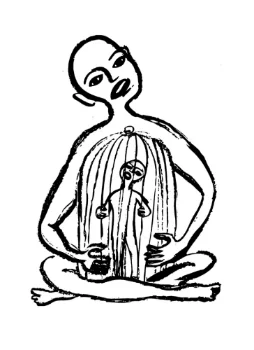It is freely available to you at:
http://pqdtopen.proquest.com/
(Merely place the author's name in the search box: Eroy).
Non-negotiated Time-Out: The Release and Return of Prisoners to American Society.
This qualitative, grounded research study aims to extend the reach of social work, criminology, clinical psychology, forensics, public policy and human evolution--both on the level of the individual and that of society.
Highlighted topics:
Corrections budget competes with educational funding (page number, as noted at the bottom of page, 133)
What defines crime, in contrast to destruction? (p. 137)
What distinguishes a sociopath from someone who merely has an antisocial personality disorder? (p. 154)
What do abusers aim to achieve? (p. 195)
Why do victims commonly feel alienated from the police? (p. 387)
How do prisons promote gangs? (p. 587)
The curse at the prison gates (p. 599)
Prisons' refrain: Homelessness (p. 624)
Drugs' role at release (p. 667)
Drug rehabilitation's elusive goals (p. 695)
Prison and death preferred to abstinence (p. 735)
Felons' relationship with God (p. 744)
Felons' children offer hope of redemption (p. 773)
A transformative experience helps at re-entry (p. 845)
Meditation lifts some (ex)prisoners upward (p. 873)
Both drug usage and prison used as a defense (p. 925)
The media's usage of felons to direct anger away from the government (p. 940)
If both prisonization and release intend to destroy felons, what is the psychological importance of this process? (p. 1006)
Prison, release, and re-entry exemplify time-out, a process not entirely dissimilar from punishing children (p. 1127)
How do (ex)prisoners conceive of their role par rapport of the government and everyday society? (p. 1309)
The unconscious as the gateway to society's reform (p. 1390)
The essence of the cure: Recognition of self-parts (p. 1492)
Criminals within ourselves (p. 1517)
Synopsis (p. 1559)
May this book bestow greater clarity and hopefulness, while empowering us to address the seemingly intractable social problems that impact us all.
********************************************************************************************************************************************
Below you can also peruse Beyond the Ego: Jainism and the Pursuit of Higher Consciousness, a short paper I wrote on Jainism. Jainism is an ancient, Indian religion that holds much wisdom about how we might live an integrous life today. (In fact, Albert Einstein practiced Jainism. In addition, Jainism was one of the most important influences that catapulted Gandhi into his far-reaching, successful, yet nonviolent, struggle with the British.)
